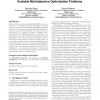210 search results - page 32 / 42 » Temporal Networks with Alternatives: Complexity and Model |
101
click to vote
BMCBI
2010
14 years 11 months ago
2010
Background: Phenomenological information about regulatory interactions is frequently available and can be readily converted to Boolean models. Fully quantitative models, on the ot...
124
click to vote
ICANNGA
2007
Springer
15 years 5 months ago
2007
Springer
In this paper we present a new method of 3D non-negative tensor factorization (NTF) that is robust in the presence of noise and has many potential applications, including multi-way...
104
click to vote
GECCO
2007
Springer
15 years 5 months ago
2007
Springer
Multiobjective evolutionary algorithms (MOEA) are an effective tool for solving search and optimization problems containing several incommensurable and possibly conflicting objec...
125
click to vote
GECCO
1999
Springer
15 years 3 months ago
1999
Springer
This paper discusses the simulation results of a model of biological development for neural networks based on a regulatory genome. The model’s results are analyzed using the fra...
130
click to vote
FUIN
2007
14 years 11 months ago
2007
Mazurkiewicz traces form a model for concurrency. Temporal logic st-order logic are important tools in order to deal with the abstract behavior of such systems. Since typical prop...


